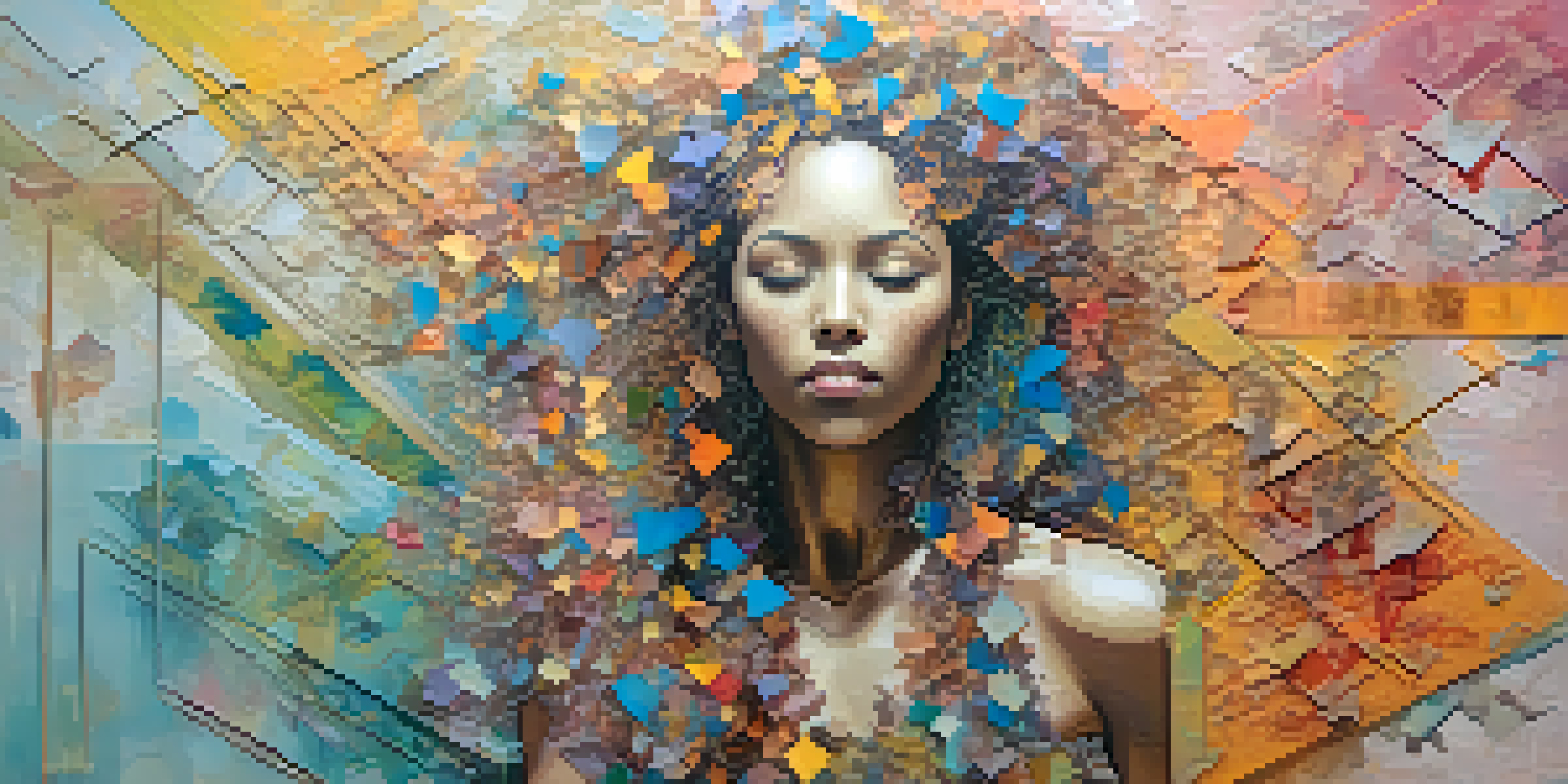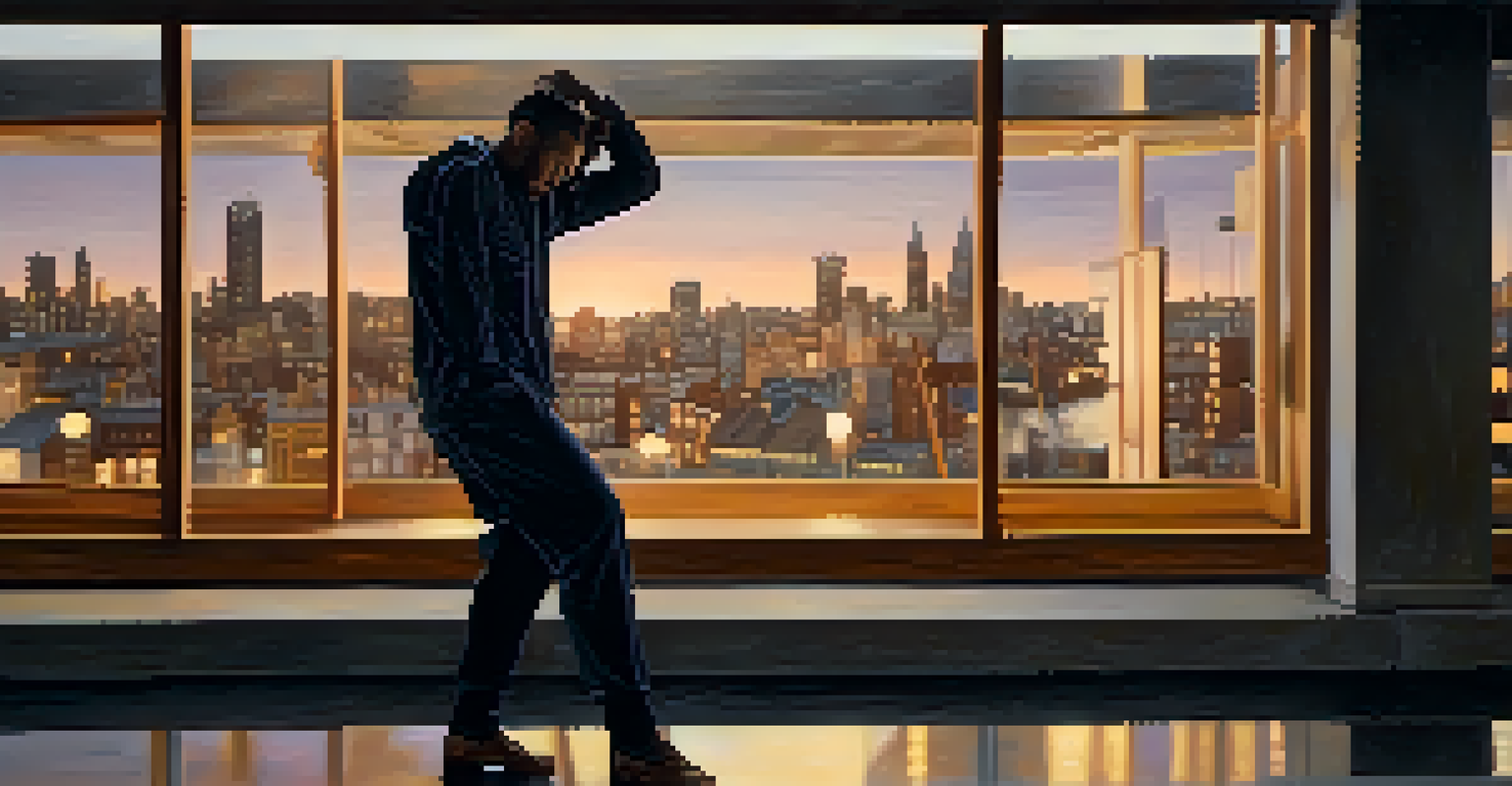Postmodern Representations of the Body in Visual Art

Understanding Postmodernism and Its Impact on Art
Postmodernism is a broad cultural movement that emerged in the late 20th century. It challenges traditional narratives and conventions, often embracing irony and playfulness. In visual art, this movement has redefined how the human body is represented, moving away from idealized forms to more fragmented and diverse portrayals. This shift reflects a deeper questioning of identity and existence in contemporary society.
Art is not what you see, but what you make others see.
As artists began to explore these themes, the body became a canvas for expressing complex identities. This focus on the body often highlights issues of gender, race, and sexuality, encouraging viewers to confront their own perceptions. For instance, the use of mixed media and performance art allows for a more interactive experience, blurring the lines between art and life. This engagement invites audiences to reflect on their own bodies and beliefs.
In this context, the representation of the body is no longer merely about aesthetics; it becomes a powerful statement. Artists like Cindy Sherman and Jeff Koons use their work to question societal norms and provoke discussions about body image. By intertwining personal narratives with broader societal issues, they create a rich tapestry of meaning that resonates with diverse audiences.
Diversity and Fragmentation in Body Representations
Postmodern art often embraces diversity, showcasing bodies in all their forms. This is a departure from the homogeneous representations of the past, allowing for a broader spectrum of identities. Artists increasingly depict bodies that reflect real-life experiences, including imperfections and variations. This approach challenges the viewer to reconsider beauty standards and societal expectations surrounding the body.

Fragmentation is another key aspect of postmodern representations. Rather than presenting the body as a whole, many artists choose to dissect it into parts, emphasizing its complexity. This technique can evoke feelings of dislocation and alienation, mirroring the chaotic nature of contemporary life. For example, the work of artist Francis Bacon often features distorted figures that convey a sense of existential struggle.
Body as a Canvas for Identity
Postmodern art transforms the body into a medium for exploring complex identities, reflecting issues of gender, race, and sexuality.
By presenting bodies as fragmented and diverse, artists can communicate the multifaceted nature of identity. This reflects the reality that individuals experience their bodies in unique ways, influenced by personal and cultural factors. Such representations encourage empathy and understanding, as viewers are prompted to engage with the complexities of others' experiences.
The Body as a Site of Political and Social Commentary
In postmodern art, the body often serves as a powerful vehicle for political and social commentary. Artists utilize their work to address issues like body politics, identity, and representation. This approach transforms the body into a battleground for discussions about power dynamics and societal structures. For instance, the works of artists like Kara Walker challenge historical narratives related to race and gender through provocative imagery.
The body is a medium, a site for the expression of identity, power, and social commentary.
By showcasing the body in various contexts, these artists invite critical reflection on the norms that govern our understanding of identity. The body becomes a symbol for broader social issues, such as consumerism and objectification. This perspective encourages audiences to question how society shapes perceptions of the body and identity, sparking dialogue and awareness.
Moreover, the use of the body in art can empower marginalized voices, allowing artists to reclaim narratives. This reclamation fosters a sense of agency and invites viewers to engage with the complexities of identity. Through these artistic expressions, the body becomes a catalyst for change, challenging viewers to reconsider their assumptions and biases.
Technological Influence on Body Representation
The advent of technology has significantly influenced how bodies are represented in postmodern art. Digital media, virtual reality, and social platforms have opened new avenues for artistic expression, allowing for innovative approaches to body imagery. Artists can manipulate images and create immersive experiences that challenge traditional notions of the body. This technological landscape invites viewers to engage with art in unprecedented ways.
For example, the rise of social media has led to a culture of self-representation, where individuals curate their own body images. Artists like Amalia Ulman use social media as a canvas, exploring themes of identity, performance, and authenticity. This blurring of lines between the artist and the audience creates a dynamic interaction that reflects the complexities of contemporary identity.
Diversity and Fragmentation
Artists embrace diverse and fragmented representations of the body, challenging traditional beauty standards and societal expectations.
Furthermore, technology raises questions about the authenticity of body representations. As artists experiment with digital manipulation, it becomes essential to consider what is real and what is constructed. This exploration challenges viewers to reflect on their own perceptions of reality, identity, and the bodies they encounter in both art and life.
Gender and the Body in Postmodern Art
Gender plays a crucial role in postmodern representations of the body, as artists explore the fluidity and complexity of gender identities. Traditional binaries are often deconstructed, allowing for a more nuanced understanding of gender. Artists like Judith Butler have influenced this discourse, suggesting that gender is performative rather than fixed. This perspective encourages artists to experiment with their representations of the body.
In many cases, postmodern art challenges stereotypes associated with femininity and masculinity. For instance, artists like Tracey Emin and Kehinde Wiley confront societal norms by presenting gender in unconventional ways. Their works empower individuals to embrace diverse expressions of gender, fostering inclusivity and acceptance within the artistic community.
By addressing gender through the lens of the body, artists prompt discussions about power, identity, and representation. This focus encourages viewers to reflect on their own experiences and the societal structures that shape their perceptions. As a result, the body becomes a site for exploring the complexities of gender and the fluidity of identity.
The Role of Performance Art in Body Representation
Performance art has emerged as a compelling medium for exploring body representation in postmodern art. By embodying ideas and concepts, artists create immersive experiences that engage the audience on a visceral level. This emphasis on the physical body allows for an exploration of identity, vulnerability, and social issues in real time. Artists like Marina Abramović have made significant contributions to this genre, pushing boundaries and challenging societal norms.
Through performance, the body becomes a tool for communication and expression. The ephemeral nature of performance art invites viewers to witness the rawness of human experience, often highlighting themes of pain, endurance, and connection. This immediacy fosters a profound engagement, as audiences are encouraged to confront their own perceptions and emotions in relation to the body.
Performance Art's Impact
Performance art engages audiences by using the body to explore identity and social issues, creating an immersive and shared experience.
Moreover, performance art often blurs the line between artist and audience, creating a shared experience. This connection invites participants to reflect on their own bodies and the societal narratives surrounding them. In this way, performance art transforms the body into a dynamic site of dialogue and exploration, enriching the discourse on identity and representation.
Conclusion: The Evolving Landscape of Body Representation
As we navigate the complexities of postmodern representations of the body, it becomes clear that this landscape is constantly evolving. Artists continue to challenge traditional norms, embracing diversity, fragmentation, and new technologies. The body serves as both a canvas and a site for exploring identity, power, and social issues, prompting critical reflection from viewers.
This ongoing dialogue encourages us to reconsider our own perceptions of the body and identity. By engaging with the diverse representations presented in postmodern art, we gain insights into the myriad experiences that shape our understanding of self. Artists play a vital role in this process, using their work to amplify marginalized voices and challenge societal constructs.

In essence, postmodern representations of the body remind us that art is not just about aesthetics; it is a powerful medium for connection and understanding. As we continue to explore these themes, we can foster greater empathy and awareness, enriching our appreciation for the complexities of human experience.